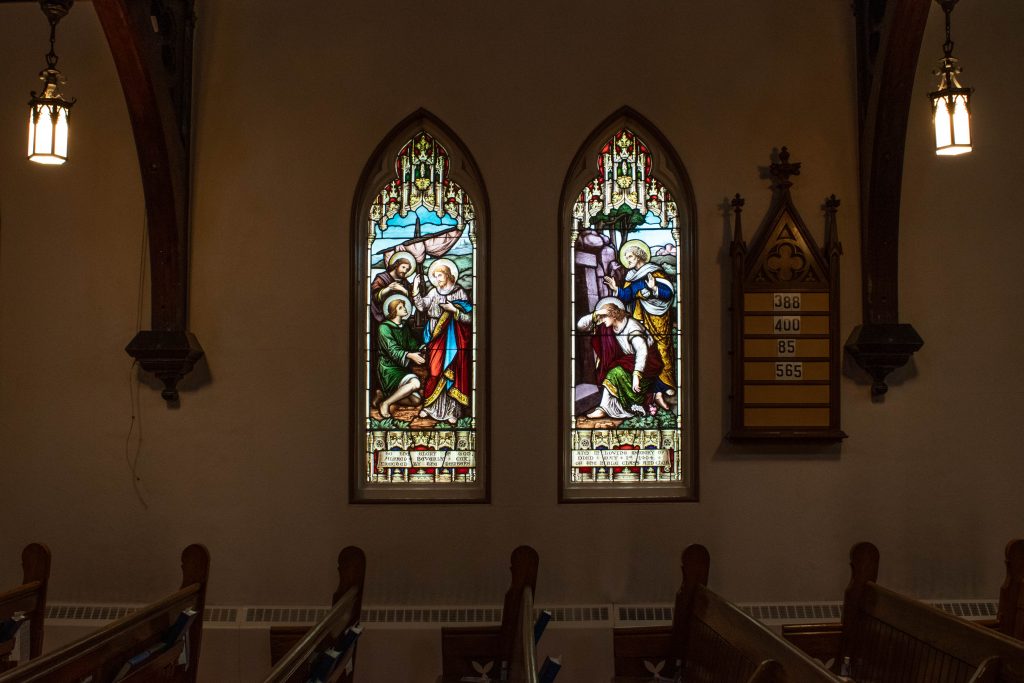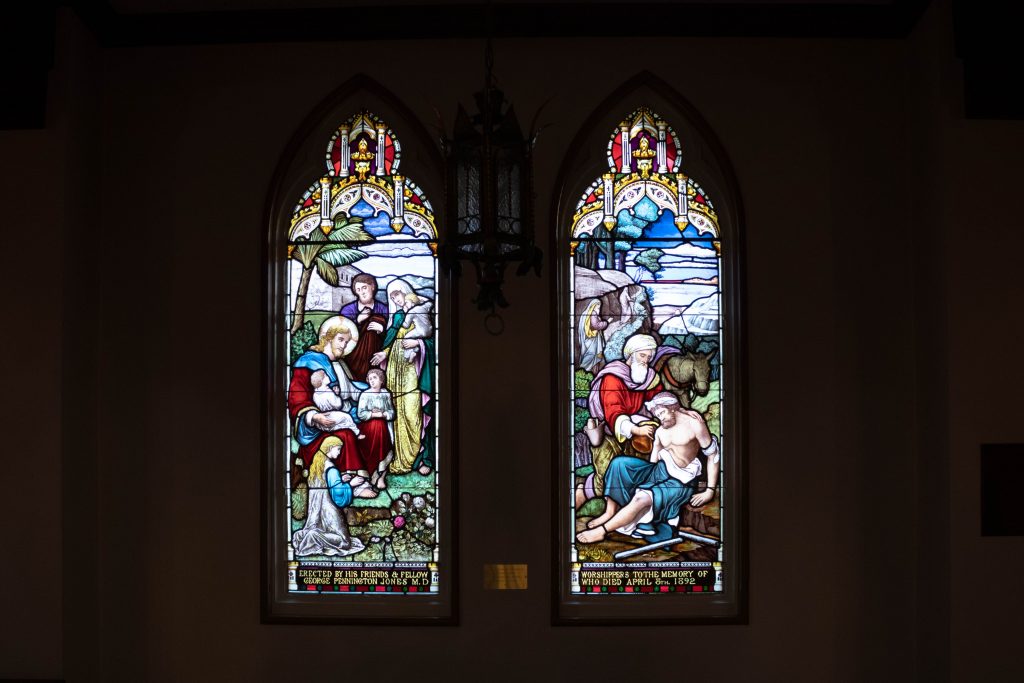9 N.T. Lyon Company, Toronto
Career and St. John the Evangelist
C. Cody Barteet
The company was started by Nathaniel Theodore Lyon who was an Irish immigrant to Canada. Like many stained glass artists in Ontario at the turn of the century, Lyon apprenticed in McCausland studios during the 1860s to 70s before establishing his own company in the 1880s. Aside from his time in McCausland studios, Lyon was trained in London, England in the studio of Edward Frampton. The N.T. Lyon Company produced thousands of windows before it was absorbed back into the McCausland Company Ltd. during the Great Depression.
On the whole Lyon’s style corresponds with that of McCausland Ltd. Both studios adopted medieval framing devices: canopies, pointed arches, medallions, plinths, and the like. Often the works included an array of flora and fauna indicative of the International Gothic styles, which flourished in Northern Europe and England, while the monumental figures are more robust and allude to the classical tradition as interpreted through Renaissance aesthetics.
Bibliography
Brown, Shirley Ann. The Stained Glass of St. James’ Anglican Cathedral, Toronto. Toronto: Anglican Archdiocese of Toronto, 2001.
Spicer, Elizabeth. Trumpeting Our Stained Glass: The Church of St. John the Evangelist, London, Ontario. London: St. John the Evangelist, 2008.
Watt, Robert D. “Heraldic Stained Glass in Vancouver.” Canadian Collector 11.3 (May/June 1976): 91-95.

John and Peter at the Sepulchre
N.T. Lyon Company, Toronto, 1905
“To the Glory of God and in Loving Memory of Alfred Beverly Cox, Died May 11, 1904. Erected by the Members of the Bible Class and Club.”
Donated by St. John’s Bible Class and Club.
Alfred Cox taught at the St. John’s Bible Class that eventually evolved into the St. John’s Athletic Club. For the church, he served as its Vestry Clerk for ten years and sometimes worked as the organist. Cox was eventually elected as a member of the Ontario Hockey Association and was President of the YMCA.

“John and Peter at the Sepulchre” is part of a diptych along the south wall. The other image, “The Calling of James and John,” relates to the calling of the saints to follow Christ and to the events after Chris’s resurrection. Here we have chosen to focus on the image of “John and Peter at the Sepulchre.” The work of the story is recorded in the Gospel of John (20:3-10) and recounts the moment that John recognizes that Christ has risen. According to the scripture, Mary Magdalene went to visit Christ’s tomb. Upon arriving at the tomb Magdalene finds it empty and rushes to tell John and Peter that Christ’s body had been moved. John rushes to the tomb and arrives before Peter. John hesitantly peers into the tomb just before he enters after Peter. Upon entering the tomb, John immediately realizes that Christ has Risen. The artists here have depicted the moment of John’s arrival as he raises his hand to look into the dark tomb just before he learns of Christ’s Resurrection.
![Lyon, Petere]](https://ecampusontario.pressbooks.pub/app/uploads/sites/1838/2021/08/28-1024x683.jpg)

Christ Blessing the Children; The Good Samaritan
N.T. Lyon Company
“To the Memory of George Pennington Jones, M.D. Who Died April 8, 1892.”
Erected by his Friends & Fellow Worshippers
Another of St. John’s diptych windows portrays scenes of the Good Samaritan (Luke 10:30-37) and the blessing of the children by Christ, which offers another variation of the depicted by Robert McCausland. The window of the Good Samaritan is among the more literal representations of religious themes. In the passages, a Jewish priest and a Levite pass a wounded man along the road. Following them was a Samaritan, who upon discovering the man, tends to the individual’s wounds and carries him to an inn; at the end, the Samaritan pays the innkeeper a wage to cover the wounder persons medical expenses. In the Lyon window, we see the Samaritan tending to the wounded man, while in the distance we see the priest and Levite in the distance, having already passed the wounded.
As Elizabeth Spicer notes, themes associated with acts of kindness and caring and compassion for our fellow man were the appropriate subject matter for a series of windows dedicated in honour of Dr. George P. Jones.[1] Dr. Jones was trained at McGill University, Trinity College, and Harvard University before he set up practice in London. Before his untimely death by a heart attack, Dr. Jones worked with the adult and boys’ choir at St. John’s.
[1] Elizbeth Spicer, Trumpeting Our Stained Glass Windows (London: St. John the Evangelist, 2008), #21.

